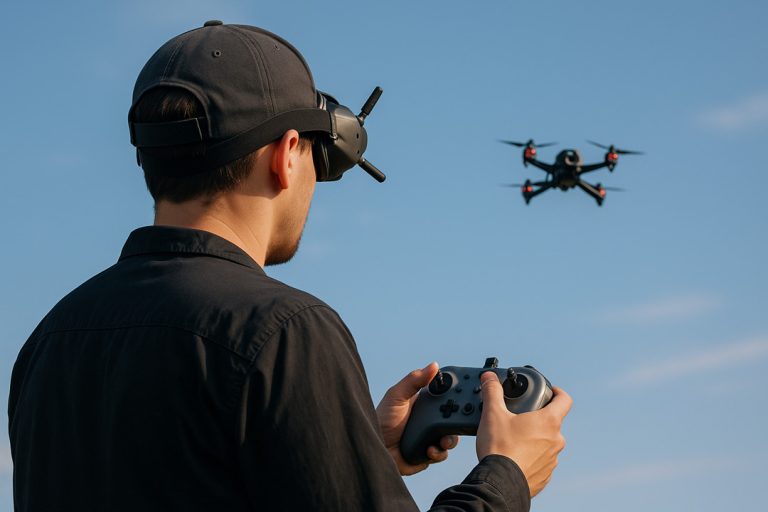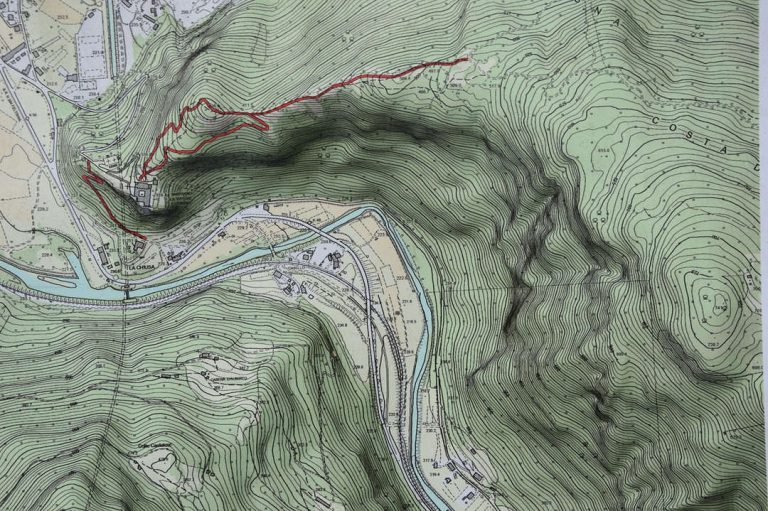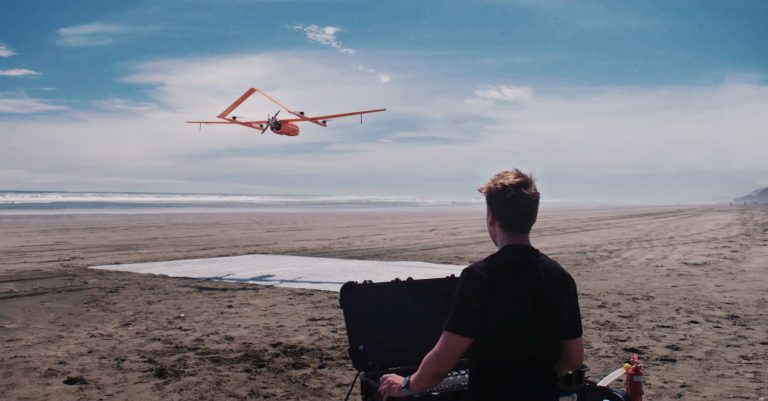Best Drones 2025: The Ultimate Expert Buying Guide
Drones are now more than just toys. At first, they were a hobby for a few people, but now they are a big industry. They change how we film, map, check things, and even farm. In 2025, drones are fast, smart, and cheap. So, this is a good time to find the one you need.
Not all drones are the same. Maybe you want great sky photos, or maybe you need one for work. Picking the right drone can be hard. Therefore, this guide can help. We will show you the best drones of 2025, from small ones for new users to big ones like the JOUAV CW-15 for work.
So, before you spend your money, read this. We will help you know what to buy and what to skip. We will also show which models are the best this year.
Best Drones 2025: Top Picks by Category
We have flown, checked data, and used many drones. Because of this, we picked our top choices for 2025. The market is clear now. We found the best drones for every use, from beginner to professional.
Best Drones for Beginners & Budget
DJI Flip
The DJI Flip is a small, 249g drone made for beginners and casual users. Its fold-out arms start the drone automatically, and propeller guards protect it from damage. The drone is easy to carry in a bag but too large to fit in a pocket.
The Flip has a 1/1.3-inch f/1.7 camera, like the Mini 4 Pro, and can record 4K video at 60fps, 10-bit D-Log M, and take 48MP photos. It works well in low light. A 3-axis gimbal keeps video smooth in calm conditions, but strong wind over 6 m/s can cause jitter. Vertical video is only possible through digital crop, not native rotation.

It has six automatic flight modes: Follow, Rocket, Circle, Spotlight, Dronie, and Custom. The drone can track subjects up to 12 m/s. Its front infrared sensor helps avoid obstacles, but it can struggle with small objects or tricky terrain. Palm launch and landing gestures are simple, but you need to place your hands carefully.
You can control it with a smartphone app using Wi-Fi for short range or with the RC controller using OcuSync 4.0 for full range. Other features include voice commands, audio sync via phone or DJI Mic, and auto power-on when unfolding. It does not support FPV goggles or waypoint missions.
Key Features:
- Weight: 249g, C0 compliant
- 1/1.3” camera, 4K/60fps HDR, 10-bit D-Log M, 48MP photos
- Six autonomous flight modes
- Infrared forward obstacle sensing
- Flight time: 22–24 minutes
- OcuSync 4.0 (controller), Wi-Fi app control
- Voice control, audio sync, auto power management
- No FPV/goggles, no waypoint missions, limited wind stability
Holy Stone HS720E
The HS720E is a foldable, mid-range drone for beginners and hobbyists. Its brushless motors, foldable arms, and sturdy build make it portable and reliable. A 7.4V 2800mAh battery gives up to 23 minutes of flight. GPS-assisted flight provides stability, Return-to-Home, and automatic modes.
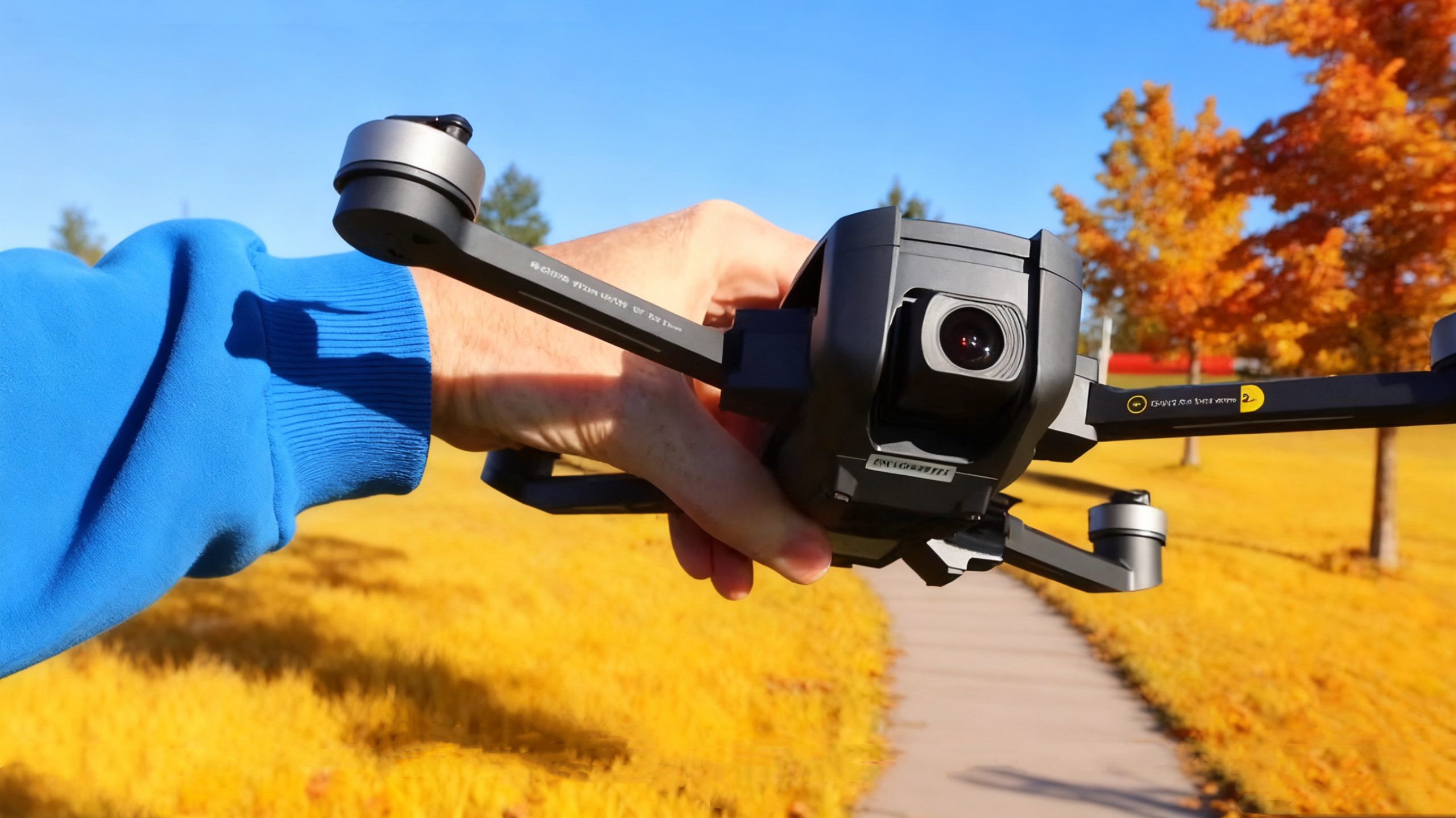
The camera is fixed but has electronic image stabilization (EIS) and can record 4K/30fps or 1080p/60fps at 50 Mbps. The mount keeps video steady in light wind. Photos and videos are stored on a microSD card. Optical flow sensors and landing lights improve stability.
Intelligent flight modes include Follow Me, Orbit, Tap-to-Fly, Headless, and Tripod Mode. The controller connects to a phone via Wi-Fi for live video. The video range is around 500 m, and the controller works up to 1 km.
Key Features:
- Foldable design with brushless motors
- Camera: 4K/30fps, 1080p/60fps, EIS
- 23-minute flight time, GPS-assisted flight, Return-to-Home
- Intelligent modes: Follow Me, Orbit, Tap-to-Fly, Headless, Tripod
- Optical flow sensor and landing lights
- Controller connects via phone app
- MicroSD support
- Lightweight with carry case
Potensic ATOM SE
The Potensic ATOM SE is a small, GPS drone similar to the DJI Mini series but more budget-friendly. It records 4K/30fps and 1080p/60fps video. The 12MP camera has a 1/3-inch Sony sensor, F2.2 aperture, and 118° field of view. It uses EIS for smooth footage but has limited lateral stabilization. The drone weighs 245g, under the 250g registration limit in many countries.

It flies up to 31 minutes per battery and uses GPS for stable flight and Return-to-Home. Video transmission works up to 2.5 miles with PixSync 2.0. Flight modes include Follow Me, Orbit, Waypoints, Return-to-Home, and sports mode up to 31 mph. Slower modes allow smooth video capture.
The controller holds your phone and gives intuitive control. The Fly More Combo includes two batteries, a carrying case, extra props, and charging cables.
Key Features:
- 4K/30fps, 1080p/60fps video, 12MP photos
- 1/3-inch Sony sensor, F2.2 aperture, 118° FOV
- Electronic Image Stabilization (EIS)
- GPS with Return-to-Home and Follow Me
- Sports mode up to 31 mph
- Intelligent modes: Orbit, Waypoints, Circle
- PixSync 2.0 video transmission, 2.5-mile range
- 31-minute flight per battery (two included)
- Lightweight: 245g
- Potensic Pro app with full control
- Fly More Combo: case, extra props, charging cables
Best Camera Drones for Photography and Videography
DJI Inspire 3
The DJI Inspire 3 is one of the main choices for professional filmmakers. It carries the Zenmuse X9-8K Air full-frame camera, which records up to 8.1K in RAW or ProRes. It also offers two base ISO levels (800 and 4000), so image quality stays clean in bright or low-light conditions. With DL interchangeable lenses (18 mm, 24 mm, 35 mm, 50 mm), users can adjust their shots easily.
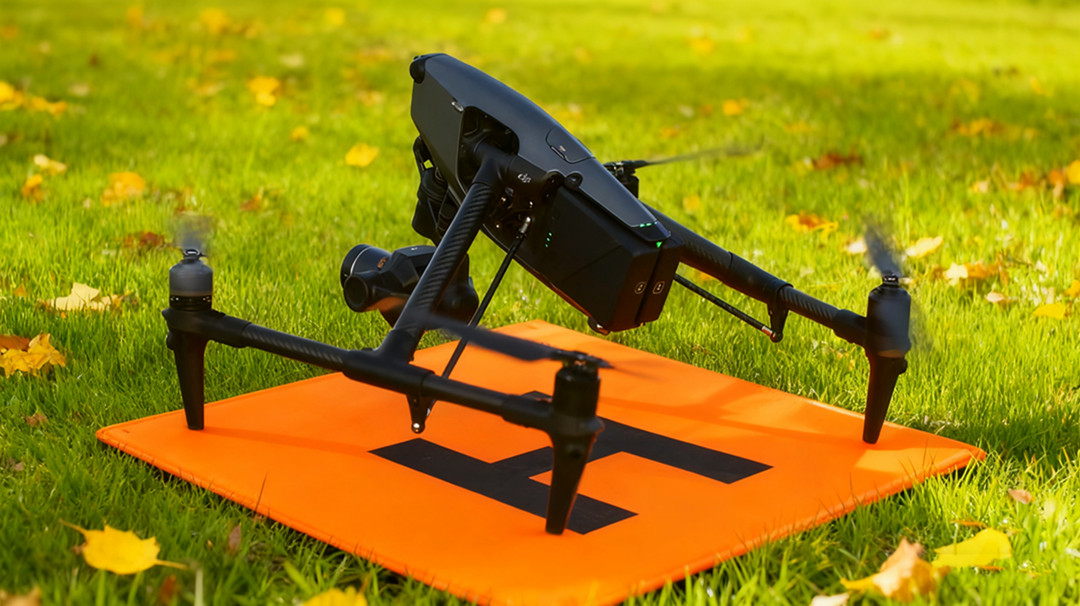
The drone’s flight system is built for precision. It includes RTK positioning, Waypoint Pro routes, and a 3D Dolly mode that repeats the same motion smoothly. The FPV camera, full-direction obstacle sensors, and dual-operator controls help pilots manage complex scenes with confidence.
The Inspire 3 uses hot-swappable batteries and stays in the air for about 25–28 minutes. The updated controller with a bright screen gives pilots direct access to camera and flight settings.
Key Features:
- 8.1K full-frame camera with DL lenses
- Dual native ISO for low-light work
- RTK, Waypoint Pro, and 3D Dolly modes
- Omnidirectional obstacle sensing
- FPV camera and dual-operator controls
- Hot-swappable batteries
DJI Mavic 3 Pro Cine
The Mavic 3 Pro Cine brings professional image quality to a foldable drone. Its three-camera system includes a 4/3-inch Hasselblad main camera, a 70 mm medium lens, and a 166 mm telephoto lens. This lets creators switch quickly between wide, medium, and long shots.
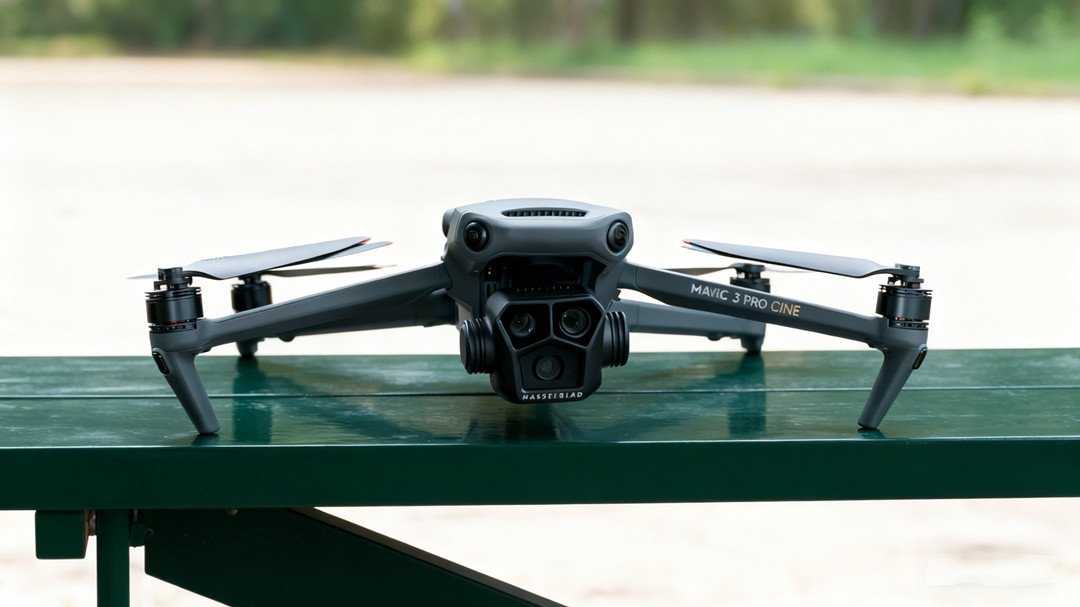
The main camera records 5.1K at 50 fps and 4K at 120 fps. All lenses support 4K 60 fps with D-Log M. The Cine edition adds Apple ProRes formats and a built-in 1 TB SSD for high-bitrate recording.
The drone flies for up to 43 minutes and uses O3+ transmission for long-range control. Its full-direction obstacle sensing, ActiveTrack 5.0, Waypoint Flight, MasterShots, and the RC Pro controller with a bright screen make operation simple and dependable.
Key Features:
- Triple-camera system: 24 mm, 70 mm, 166 mm
- 5.1K/50 fps and 4K/120 fps recording
- Apple ProRes support with 1 TB SSD
- 43-minute flight time
- Waypoint, FocusTrack, Hyperlapse, and MasterShots
Autel EVO Max 4T
The Autel EVO Max 4T is made for industrial tasks such as inspection, search and rescue, and complex field operations. Its four-sensor camera system includes an 8K zoom camera, a wide 50 MP low-light camera, a thermal camera, and a laser rangefinder. This combination gives users strong awareness in many environments.

The 8K zoom camera offers 10× optical and up to 160× hybrid zoom, allowing clear long-distance viewing up to 2 km away. The low-light sensor performs well at night. The thermal camera provides temperature readings with 16× digital zoom. The laser rangefinder measures up to 1.2 km with one-meter accuracy.
The drone includes 720° obstacle avoidance, hot-swappable batteries, and a foldable IP43-rated frame. The 7.9-inch controller provides real-time 1080p video and easy mission planning. Its anti-jamming system and A-Mesh networking allow multiple drones to work together.
Key Features:
- Quad-camera system: 8K zoom, wide, thermal, laser rangefinder
- 10× optical / 160× hybrid zoom
- 720° obstacle sensing and IP43 protection
- Hot-swappable batteries
- Anti-jamming and A-Mesh multi-drone support
Best Commercial & Professional Drones
JOUAV CW-15 VTOL Drone
The JOUAV CW-15 is a professional fixed-wing VTOL drone designed for long missions in challenging environments such as forests, cliffs, or moving vehicles. It can fly for 180 minutes and cover up to 50 km. Its VTOL design allows it to take off and land vertically on rough or moving surfaces, making it flexible for mapping, surveillance, and emergency response.
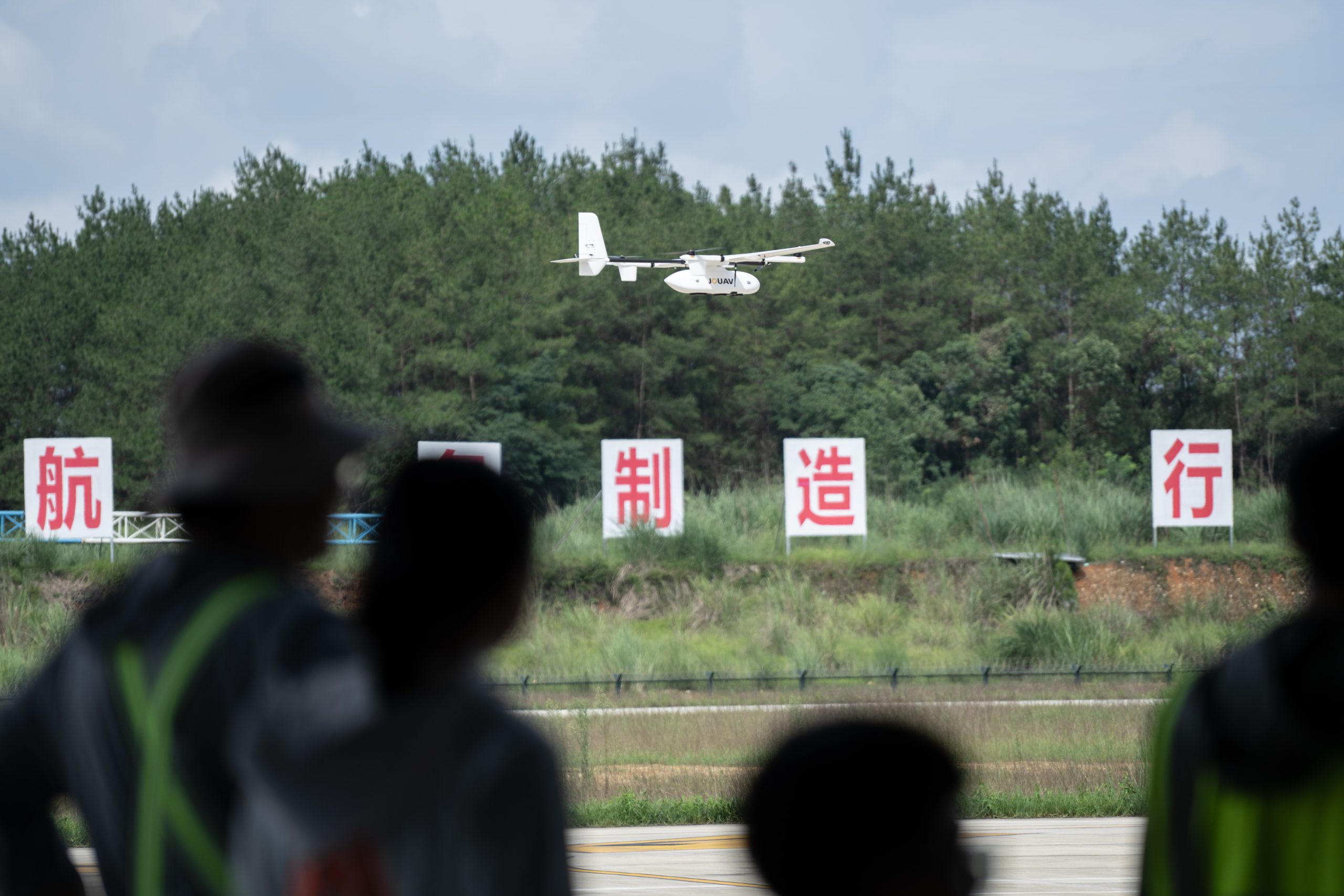
It carries the MG-120E gimbal payload, which includes a 30x optical zoom 1080p camera and a 640×512 thermal sensor. AI-powered recognition and tracking work on a 3-axis gimbal for day and night monitoring. Real-time video streaming supports quick tactical decisions.
The CW-15 has a smart battery system, data encryption, ADS-B detection, and automatic obstacle avoidance for safe and efficient flight. Using JoCloud, teams can monitor multiple drones, detect hazards with AI, and share data. An open SDK allows customization of payloads and software for different missions.
Key Features:
- MG-120E gimbal: 30x zoom, thermal imaging, 3-axis stabilization
- AI recognition, tracking, real-time streaming
- 180 min flight, 50 km range, 61 km/h cruise
- VTOL takeoff/landing on rough surfaces
- Smart battery, data encryption
- ADS-B detection, auto obstacle avoidance
- Operates in -20°C to 50°C, wind up to 13.8 m/s
- JOCloud monitoring and AI hazard detection
- Open SDK for custom payloads
DJI Matrice 350 RTK
The DJI Matrice 350 RTK is a high-end enterprise drone for inspection, security, and emergency tasks. It is larger and less portable, requiring three separate cases for the drone, batteries, and payload. It can fly up to 55 minutes, with an 8 km transmission range, and is rated IP55 for weather resistance.
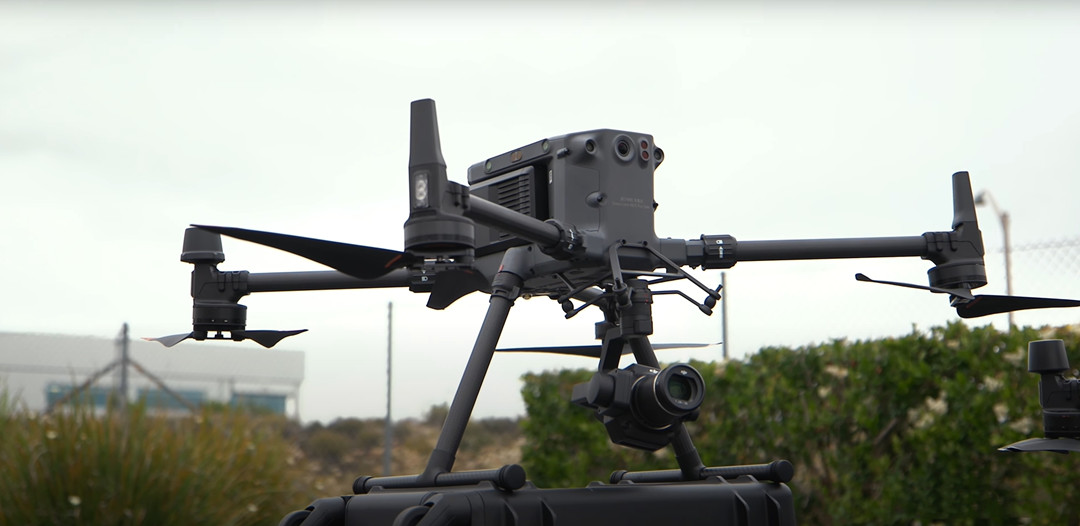
The drone improves on the Matrice 300 RTK with better weatherproofing, six-directional obstacle sensing, and a DJI RC Plus controller. It supports multiple payloads including cameras, thermal sensors, spotlights, and loudspeakers. Dual-operator control lets one pilot fly while another manages the gimbal.
Flight is stable in rain, snow, and strong winds. Hot-swappable TB65 batteries allow continuous use. The O3 Enterprise transmission system maintains data links up to 20 km. The M350 RTK is ideal for night operations, surveillance, and first-responder tasks.
Key Features:
- Flight time: up to 55 minutes (35–45 min typical)
- Transmission range: up to 8 km
- Weather resistance: IP55, wind up to 12 m/s
- Controller: DJI RC Plus, dual-operator support
- Obstacle avoidance: six-directional sensing
- Payload: multiple sensors, compatible with M300 payloads
- Hot-swappable TB65 batteries
- Camera options: RGB, thermal, infrared, FPV night vision
- Foldable arms, transport cases with wheels
- Applications: surveillance, inspection, firefighting, law enforcement
Autel Dragonfish
The Autel Dragonfish is a professional VTOL drone that combines multirotor hovering with fixed-wing efficiency. It is designed for search and rescue, surveillance, and infrastructure inspection. The drone has a long endurance and strong wind resistance, making it suitable for demanding conditions.
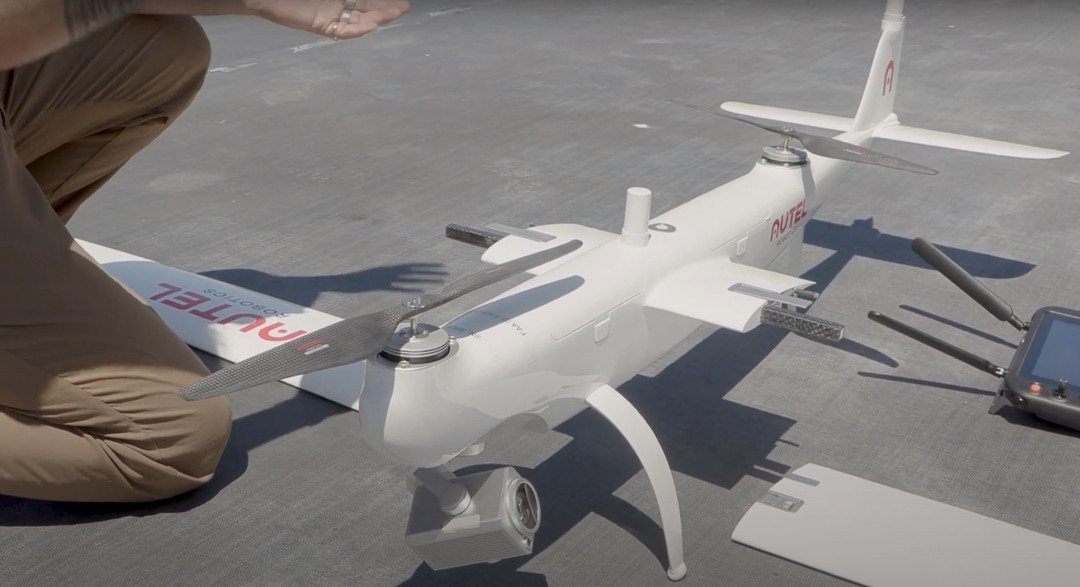
It can fly up to 27 km (17 miles) and reach cruise speeds of 70–100 km/h. The modular payload system supports electro-optical, infrared, and multispectral sensors. Vertical takeoff transitions smoothly into horizontal flight. A smart controller with a repeater station ensures consistent communication and real-time data across large areas. Automated takeoff, landing, and waypoint functions simplify operations.
The Dragonfish is intended for professional use and requires significant investment and expertise. Its performance, long-range endurance, and flexible payload make it suitable for agencies conducting complex missions.
Key Features:
- VTOL hybrid design: multirotor takeoff, fixed-wing efficiency
- Flight range: up to 27 km
- Cruise speed: 70–100 km/h
- Long endurance for extended missions
- Modular payload: EO, IR, multispectral sensors
- Dedicated controller with repeater for long-range communication
- Applications: search and rescue, public safety, infrastructure inspection
- Strong wind resistance and automated flight functions
Best FPV and Racing Drones
DJI Avata 2
The DJI Avata 2 is a cinewhoop-style FPV drone that combines immersive first-person flying with DJI’s safety and smart features. It works well for beginners while also offering stable FPV footage for cinematic creators.

The Avata 2 uses the DJI O4 Air Unit for clear 1080p transmission and can record 4K/60fps D-Log M video. It works with DJI Goggles 3, FPV Remote 3, and Motion Controller 3 for easy control. Its polycarbonate ducted design improves safety, and the adjustable gimbal tilt allows creative angles.
Flight time is up to 16 minutes. USB-C charging, smart flight modes, and motion control make it travel-ready and convenient. Safety features include Return-to-Home, obstacle awareness, and geofencing.
Key Features:
- 1080p low-latency FPV via DJI Goggles 3
- 4K/60fps D-Log M recording
- Flight time up to 16 minutes
- Normal, Sport, and Manual flight modes
- Adjustable camera tilt for cinematic angles
- Compact, lightweight, USB-C charging
- Safety: Return-to-Home, obstacle sensing, geofencing
BetaFPV Pavo 20 CineWhoop
The BetaFPV Pavo 20 Pro is a 2.2-inch cinewhoop drone for cinematic and light freestyle flying. It works with DJI O4 Pro for high-quality digital video transmission. The drone is lightweight at 154 g (with battery) and stays under 250 g for easier flight rules.
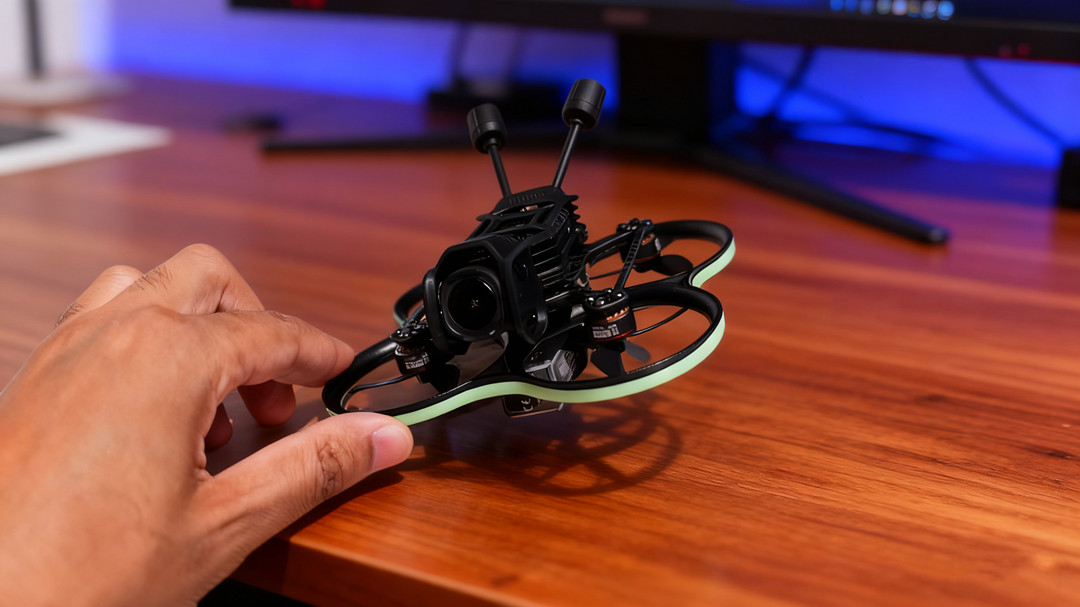
It uses 1104 7200KV plug-in motors and 3S batteries for best performance. A soft-mounted camera canopy and bottom-mounted battery improve video stability. Built-in LED strips and an ELRS receiver allow customization.
The Pavo 20 Pro flies slowly and precisely for smooth cinematic shots indoors or close to objects. Battery life is about 5 minutes on a 550 mAh pack. It handles mild freestyle moves, and crash resistance is strong. Preconfigured Betaflight modes make it easy for beginners.
Key Features:
- 2.2-inch cinewhoop, 154 g with battery
- DJI O4 Pro digital FPV system
- 1104 7200KV motors, plug-in design
- Optimized for 3S LiPo battery (~5 min flight)
- Built-in ELRS receiver
- Soft-mounted camera for vibration reduction
- LED strips, customizable
- Sub-250 g takeoff weight
- Crash-resistant, modular frame
- Quiet and safe for indoor use
iFlight Nazgul5 V3
The iFlight Nazgul5 V3 is a 5-inch FPV drone built for experienced pilots. It uses a 6S battery and has the DJI O4 Pro digital FPV system with long-range antennas. The frame can switch between Deadcat and X-frame layouts for cinematic stability or freestyle agility.
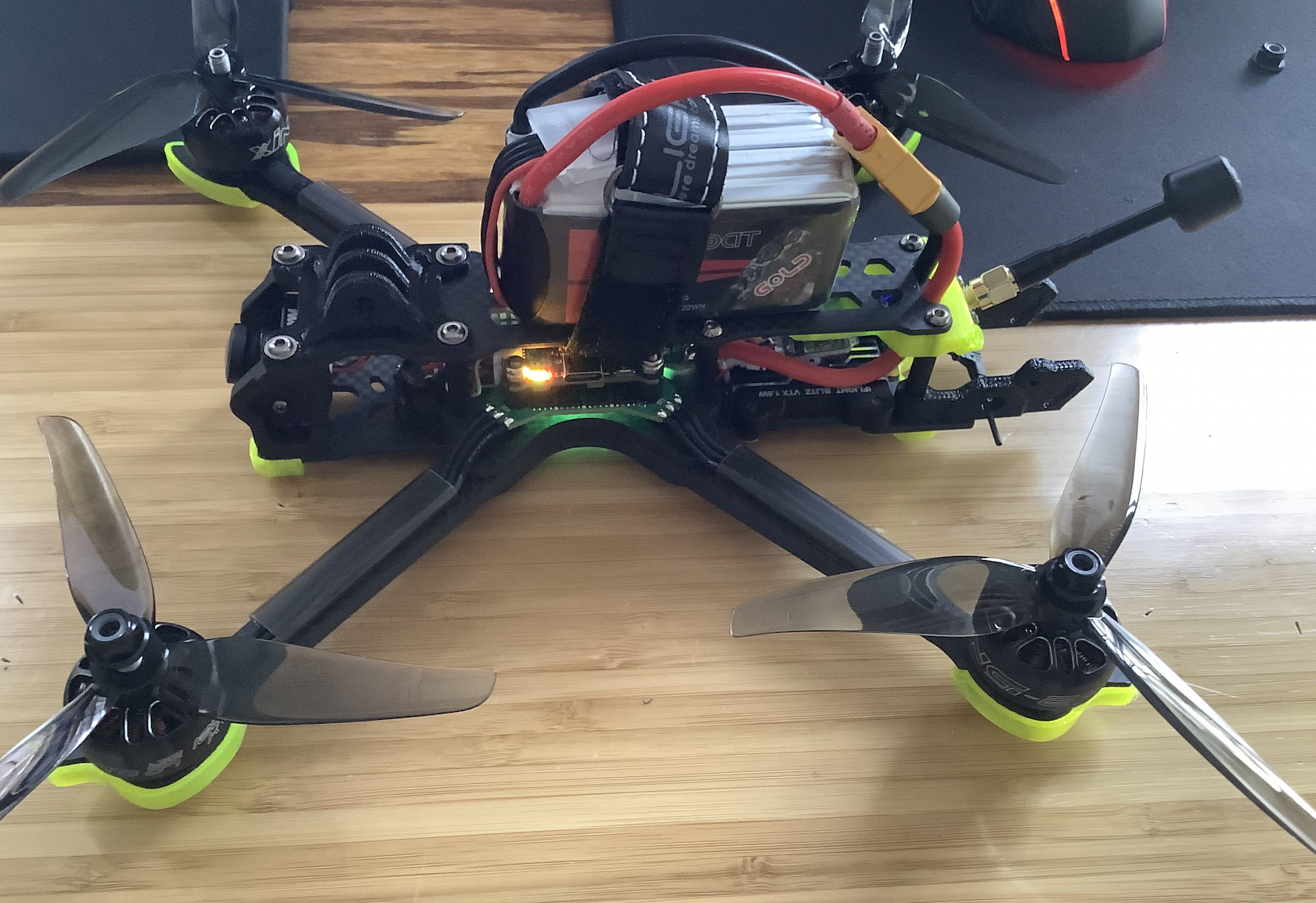
It is fast and powerful, reaching speeds up to 138 km/h. The F7 flight controller, 60A ESC, and 1750KV brushless motors deliver precise control. GPS Rescue automatically returns the drone if the signal is lost.
The Nazgul5 V3 has a strong carbon fiber frame, aluminum protection, and supports GoPro mounts. Flight time is about 8–13 minutes depending on the battery. It is designed for intermediate to advanced FPV pilots, not beginners.
Key Features:
- 5-inch FPV quad, 6S battery
- Switchable Deadcat/X-frame
- DJI O4 Pro with long-range antennas
- Foldable GPS with Rescue mode
- LED lighting for night visibility
- F7 controller + 60A ESC + 1750KV motors
- Speeds up to 138 km/h
- Carbon fiber frame with aluminum protection
- GoPro mount included
- Flight time: 8–13 minutes
Best Public Safety & Defence Drones
JOUAV Multirotor Hangar
The JOUAV Multirotor Hangar is a fully autonomous “drone-in-a-box” system combining the PH-10H multirotor, the JOS-P200 docking station, and JoCloud for 24/7 automated operations. It supports automatic battery swaps, climate-controlled housing, and rapid deployment in under a minute.

Designed for security, inspection, smart-city, and emergency missions, the PH-10H carries up to a 6 kg payload with 35–60 minutes of flight time depending on the payload. The system operates reliably from –30 °C to +50 °C and supports up to four simultaneous payload modules.
The docking station allows fixed or vehicle-mounted installation, features high-speed communications (Ethernet, fiber, 4G/5G), 2-hour UPS backup, and requires maintenance only every six months, making it ideal for continuous, unmanned field deployment.
Key Features:
- Fully automated docking with battery swaps
- PH-10H multirotor: 35–60 min flight, up to 6 kg payload
- Up to four payload modules: camera, loudspeaker, search-light, parachute
- Communication: 15 km drone range, 4G/5G mesh links
- JOS-P200 docking station: –30 °C to +50 °C, <249 kg, 2-hour UPS
- Rapid deployment: <1 min first launch, <1.5 min subsequent launches
- 360° obstacle avoidance (LiDAR, radar, stereo vision)
- Cloud platform (JoCloud) for planning, analysis, fleet management
DJI Mavic 3 Thermal (M3T)
The DJI Mavic 3 Thermal is a compact, professional-grade thermal drone suitable for public safety, inspection, and engineering tasks. Lightweight and deployable in under a minute, it offers up to 45 minutes of flight, strong wind resistance (26 mph), and operation from –10 °C to +40 °C.
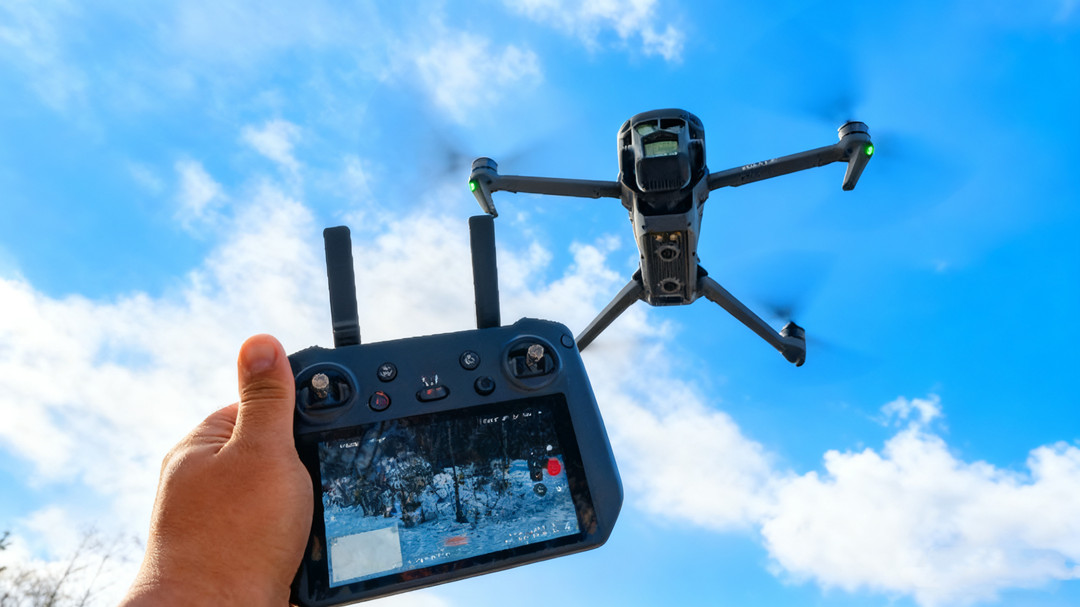
It features a 640 × 512 thermal sensor, 56× hybrid zoom camera, and 48 MP wide-angle sensor for detailed thermal and visual inspections. Omnidirectional obstacle avoidance, intelligent mapping, and dual thermal/visual display on the smart controller enhance situational awareness.
Priced around $6,200 (enterprise bundle), the M3T is a cost-effective solution for first responders and engineers seeking advanced aerial thermal capabilities.
Key Features:
- 640 × 512 thermal sensor; 56× hybrid zoom, 48 MP wide-angle camera
- Up to 45 min flight, 26 mph wind resistance
- Operating range: –10 °C to +40 °C
- Rapid deployment (<1 min), portable design
- 9-mile OcuSync 3 Enterprise transmission
- Smart controller with side-by-side thermal + visual display
- Omnidirectional obstacle avoidance, mapping tools
- Optional accessories: spotlight, speaker
Skydio 2
The Skydio 2 is an AI-driven autonomous drone known for its advanced obstacle avoidance and self-navigation. Equipped with six 4K navigation cameras, it builds a real-time 3D map to safely fly through forests, under bridges, or around complex environments.
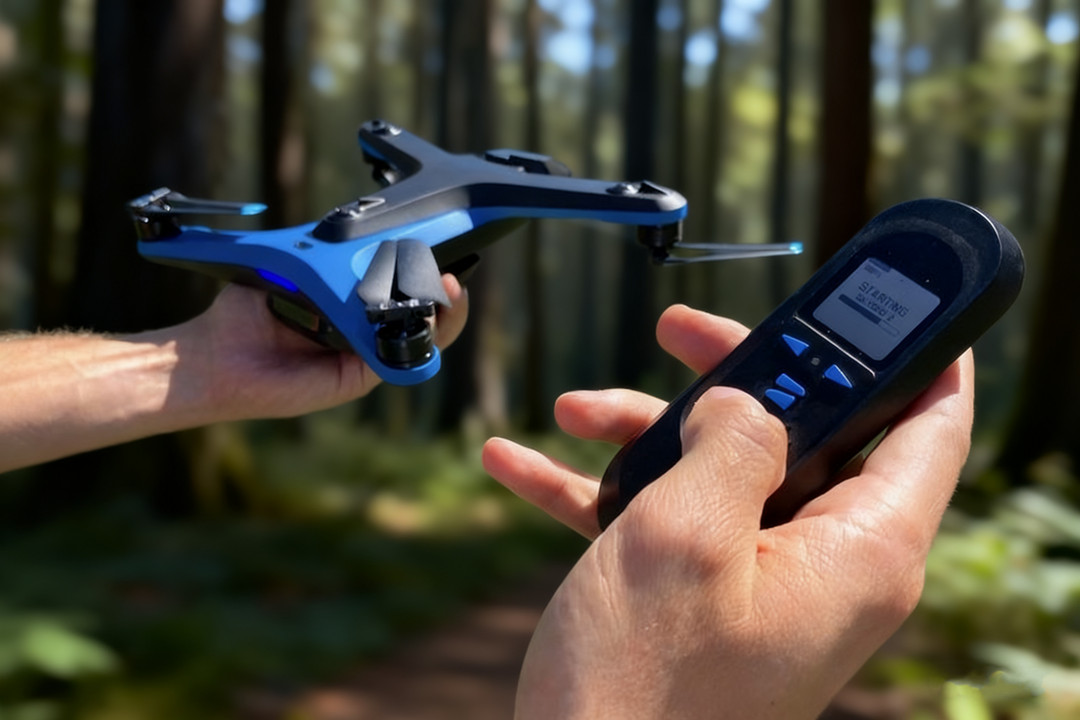
Control options include a smartphone, Skydio Beacon for extended GPS tracking, or a dedicated controller. The drone eliminates compass calibration and is resistant to magnetic interference. Its compact, durable design supports magnetic batteries and clip-on ND filters for quick field use.
Skydio 2 records 4K60 HDR video with around 20–23 minutes of flight time. Its autonomy and obstacle avoidance make it one of the safest drones available, ideal for creators, explorers, and professionals in complex or risky environments.
Key Features:
- Six 4K navigation cameras for 360° obstacle avoidance
- AI-powered autonomous flight and 3D mapping
- Beacon for GPS tracking when out of sight
- Optional remote controller for precise manual piloting
- 4K60 HDR video quality
- Magnetic batteries and clip-on ND filters
- No compass calibration required
- 20–23 minutes flight time
- Compact, lightweight, non-foldable design
How to Choose the Right Drone in 2025 (Drone Buying Guide)?
To find the right drone, you need to match its features to what you actually want to do. Think about your needs, your budget, and your skills.
First, Decide What You Need It For
- For fun and travel: Get a small, light, and foldable drone. It should be simple to use with a good camera (12-20 MP, 4K video) and fly for more than 25 minutes.
- For making videos: You need a drone with a stabilized camera (a gimbal). Look for a large sensor, professional video settings, and a battery that lasts over 30 minutes.
- For FPV / acrobatic flying: You need a small, tough drone built for tricks. Flight times are short, so you need many batteries. You should also be able to repair it easily.
- For work like mapping or inspections: These drones need special features, like thermal cameras. They must have very long battery life, secure signals, and professional support.
- For racing: These drones are built to be as light and fast as possible. They are often custom-made.
Understanding the Camera
- Sensor size is key. A bigger sensor takes better pictures in low light. For professional work, get a 1-inch sensor or larger.
- Resolution and quality: 4K video is standard. Higher-quality video files give you more editing flexibility.
- A gimbal is important. A 3-axis gimbal is best for smooth video. Electronic stabilization helps, but it's not as good as a real gimbal.
- For professional editing, make sure the drone can shoot in RAW or LOG formats.
Battery and Flight Time
- Real flight time is less than advertised. You will usually get 75-90% of the claimed time. Always plan to land with some battery left.
- Buy extra batteries. You should have at least 2-3 batteries. Think about how you will charge them, especially when away from home.
- Weather affects batteries. Cold weather makes batteries drain faster.
Safety and Avoidance Systems
- Sensors help avoid crashes. Drones with sensors on all sides are much safer, especially for beginners.
- "Return to Home" (RTH) is vital. This feature makes the drone fly back to you automatically if it loses signal or runs low on battery.
- Beginner modes are helpful. They limit the drone's speed and distance so you can learn safely.
Control Range and Signal
- Transmission systems vary. The type of system determines how far away you can fly and how clear the video signal is.
- Don't expect the maximum range. Real-world range is always lower than the advertised number. Buy a drone with more range than you think you need.
- Low latency is key for FPV. A fast response time is critical for acrobatic flying.
Size, Weight, and Rules - Folding drones are good for travel.
- Weight is very important. Drones under 250 grams have simpler rules in many places. Heavier drones often require registration. Always check your local laws.
Durability and Repairs
- Check the build quality. Carbon fiber is strong and light.
- Modular drones are easier to fix. Look for drones where you can easily replace parts like motors.
- Make sure spare parts are available. You don't want to wait weeks for a repair.
- Software and Apps
- A stable app is necessary. The app should let you plan flights and access important features.
- For professional use, check if the drone allows for custom apps and software development.
Controllers and User Experience
- Controllers with built-in screens are convenient. Dedicated controllers often have better response times.
- For FPV flying, you will need to choose compatible goggles and a radio controller.
Cost and Ownership
- Set a budget. Drones range from under $300 to over $3,000.
- Remember the total cost. Include the price of extra batteries, a case, filters, and possible insurance.
- Look at the warranty and what repair services are offered.
A Simple Buying Checklist
- Does it fit what I want to do?
- Is the camera and gimbal good enough?
- Is the real flight time long enough? How many batteries do I need?
- Does it have good safety features like sensors and RTH?
- Does it have enough range for me?
- What are the rules for a drone of this weight?
- Are spare parts easy to get?
- Is the app good and does it have the features I need?
- Is the controller included and is it good?
- What is the total cost with all accessories and warranty?
Is It Better to Buy a RTF Drone or Build One Yourself?
Your choice depends on whether you want convenience or full control.
Ready-to-Fly (RTF) Drones
These come fully built and are ready to use. They are the best choice for most people.
- Pros: Very easy to start. They are reliable and have built-in safety features. They offer great value and are perfect for photography.
- Cons: Less customizable.
Building Your Own Drone
This means you buy all the parts and assemble the drone yourself.
- Pros: You have total control over the parts. It is easier to repair because you built it. It can offer higher performance for racing. It is a very rewarding hobby.
- Cons: It has a steep learning curve. It requires time, patience, and technical skill to build and troubleshoot. It is often not cheaper than buying an RTF drone.
In short, if you want to fly easily and take great videos, buy an RTF drone. If you love technology and want a custom project, then build your own.



